Columns
Scholar monk’s erudite voice of ‘Satyam Shivam Sundaram’ stilled
View(s):TRAGIC DEATH OF VEN WIMALARATaNa THERA: LANKA’S GUARDIAN DEITY OF PEOPLE’S RIGHTS
Temple tusker Myan Kumara flays the venerable hand that fed it; and shrouds the nation in a veil of mourning
All life dances on a razor blade. And for Venerable Bellanwilla Wimalaratana Thera, death came from the most unexpected quarter last Friday: from his own Bellanwilla temple’s temperamental teenage tusker’s trunk.
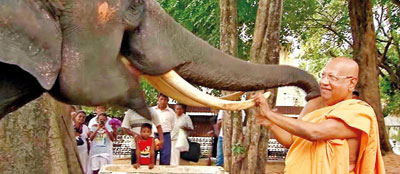
THE MONK AND THE ELEPHANT: Every morn at dawn, the Ven Wimalaratana Thera used to feed the teenage tusker he had brought down from Myanmar with balls of tamarind and a platter of fruits
Seven years ago with the death of the then temple’s tusker which had majestically borne for long the sacred relics at the annual Bellanwilla perehera, Wimalaratana Thera embarked upon a search to find a suitable tusker to replace the fallen. His search led him to Myanmar in 2012,
The Myanmar Government offered him the opportunity to select one from its pool of young tuskers still in their teething years. It was not a simple process of selecting one with tusks beautiful. The one fit to bear the sacred relics had to fit the traditional requirements. To be eligible it had to be from the Siddhantha caste of elephants.
The trunk had to be of perfect length, not only touching the ground but coiling up. Its countenance, its natural gait, its ability to keep its head held high had to be gauged before final selection. From the trunk to the tail, the body should be in perfect proportion. And most important of all, the plateau on his back should be broad and flat enough to bear the casket enshrining the sacred relics of the Buddha. Nothing else would do.
 When presented with the choice host of young tuskers for selection, the venerable monk’s eyes fixed on one: the decision was made. And with the munificence of the Myanmar government, arrangements were made to transport the young tusker to Lanka’s shores to be the future temple tusker to carry aloft on his back, the symbol of a nation’s worship. On June 4, 2013, the tusker was formally handed over to the Bellanwilla Raja Maha Viharaya and named Myan Kumara by Bellanwilla Wimalaratana Thera as the tusker in waiting to bear the casket in the years to come.
When presented with the choice host of young tuskers for selection, the venerable monk’s eyes fixed on one: the decision was made. And with the munificence of the Myanmar government, arrangements were made to transport the young tusker to Lanka’s shores to be the future temple tusker to carry aloft on his back, the symbol of a nation’s worship. On June 4, 2013, the tusker was formally handed over to the Bellanwilla Raja Maha Viharaya and named Myan Kumara by Bellanwilla Wimalaratana Thera as the tusker in waiting to bear the casket in the years to come.
Little did the venerable monk know that he had personally chosen the ‘Mara’ of his own demise and invited him in to his temple domain to strike when the hour comes to one, even as it comes to all. That inevitable tryst with fate — even as Arahant Moggalana, one of the two chief Arahants from which the Buddha’s Sangha descends, kept his rendezvous with the consequences of a past karma done in a previous birth even after attaining Arahantship — is the common lot of all.
Past karmic action did not even spare the Buddha. For doesn’t the Buddhist text relate not only the story of how the tusker Nalagiri sent drunk by the Buddha’s cousin Devadatta to kill him, knelt down in worship before the Enlightened One’s beneficence but also tell of the story of how a splinter of a rock hurled by the same cousin Devadatta, struck the Buddha’s big toe and caused it to bleed due to the unforgivable action of once having insulted Paccheke Buddha in a previous birth?
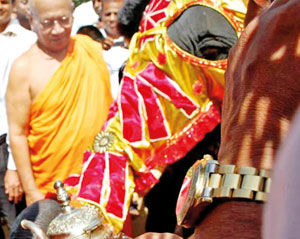
JUNE 5TH 2013: The day the tusker came to Bellanwila.
That is the Buddhist philosophical explanation for the monk’s untimely death. No need for any cover up as some attempted to do to conceal the truth in the first hours of the tragedy that the venerable monk had been struck down by the temple’s tusker and thought fit to attribute to an incident at the temple.
Men in this present birth and existence can live exemplary lives and still meet tragic ends. The modern saint of the Twentieth Century Mohandas Gandhi was shot. Two thousand years ago, Jesus Christ died crucified on the cross. Does the manner of their deaths deny Gandhi his sainthood or Christ his position as the son of God? Even as Jesus said on the cross, “Father forgive them, for they know not what they do,” perhaps it was ignorance that prompted the venerable monk’s acolytes to take that path, not forgetting, of course, the shock they would have suffered learning of the revered monk’s sudden demise. As the late venerable monk would have been the first to exclaim “why fear truth”.
Especially when his life was based on that one guiding tenet: to speak the truth regardless of the consequences. As Keats’s put it in his Ode on a Grecian urn ‘beauty is truth, truth beauty’. And in Sanskrit as the Indian sages of old held, ‘Satyam Shivam Sundaram’: Truth is God and it’s beautiful. And that was all, the venerable monk needed to know to embrace it as his personal credo to launch his worldly crusade to gain justice for the people of Lanka.
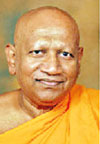
LOST TO THE NATION: Venerable Bellanwilla Wimalaratana Thera’s erudite voice
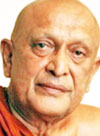
LOST TO THE NATION: Venerable Maduluwawe Sobitha Thera’s moral voice
And that is why, tens of thousands came from all corners of the island to pay their last respects and bid final farewell to the mortal remains of the monk who had fearlessly spoken out on their behalf without fearing the backlash of Lanka’s political masters.
He had become the guardian deity of the people’s rights. And his temple lay in the Bellanwila Raja Maha Viharaya. And his scholarly background gave him the intellectual prowess to become a formidable crusader and defender of the democratic faith.
He read for a doctorate in philosophy in 1980 at the University of Lancaster, United Kingdom. He served as professor, associate professor, lecturer and visiting lecturer of the Sri Jayewardenepura University and in 2000 was appointed as its chancellor. He was also a visiting professor at the School of Oriental and African Studies, University of London, United Kingdom.
And unlike others who draped themselves with the saffron robe and raised the lion flag of chauvinism to attack other communities and their religious creeds, the venerable Bellanwila Thera used the inherent power of the robe to promote national harmony and reconciliation.
If the late Venerable Maduluwawe Sobitha Thera had been in recent years the moral voice of the nation, the erudite Venerable Bellanwila Thera had been its intellectual counterpart. Both monks had one common trait. Both were fearless and both attacked wrongs and injustices no matter from which political camp it emanated. Both kept check on politicians. They did not speak or act for any personal gain or privileges nor did they have a political agenda. Whether the alms came in duty free limousines of the rich and powerful to court their favour or whether it was brought on foot by the poor with shraddha in their hearts to gain merit to transfer the same to their beloved dead, they viewed both with equanimity. To have lost them within a period of less than two and a half years is a national tragedy. It has left a vacuum that cannot be filled.
His untimely death reveals the fickleness of life: That even the bright flame that illumines the dark night can be snuffed with one small gust of wind. It should serve as an illustration to politicians who speak and act and strut on the political stage as they were immortals that all life dances on a razor blade. Without a safety net.
May the most Venerable Bellanwilla Wimalaratana Thera attain the Supreme Bliss of Nirvana.
Mysterious power of the Bellanwila Bodhi 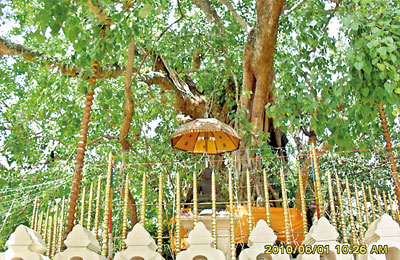 THE BELLANWILA BODHI TREE: One of the 32 first saplings from the Jayasiri Maha Bodhi At the Bellanwila Raja Maha Viharaya, the Bodhi Tree holds centre stage and its proclaimed miracles draw pilgrims to its roots like pins to a magnet. For long had the Bellanwila Bodhi remained hidden, covered in dense foliage following the Portuguese invasion in the 1505 AD and the invaders subsequent dominance over the coastal areas. And, as a result, it had remained concealed from human eye until the sound of distant drums was heard by an adventurous monk whilst travelling on a boat on the Katu-ela stream towards neighbouring Pepiliyana. It mystified him. It beckoned him. He felt himself compelled to answer the call of the distant drums. Its haunting thump and intoxicating throb drew him inexorably to the thicket from whence it pounded its heady beat. The monk, Thengodagedara Hamuduruwo, ordered the boatman to stop. And after alighting from the boat he made his way toward the source of the sound the mystique drums made. But the sound of the drums that had resounded so loud grew fainter and fainter as he approached its source and suddenly stopped. In the morning light Thengodagedara Hamuduruwo, found himself before a Bodhi Tree. With his curiosity stirred why the call of the distant drums had led him to this Bodhi Tree, he embarked on a voyage of discovery and soon discovered the history and literature of the land, that there had existed upon that hallowed spot an ancient temple now gone to seed and reduced to ruin but a Bo tree evergreen, a Bodhi tree as Thengodagedara Hamuduruwo found to his amazement was one of the thirty two saplings from the sacred Bodhi-tree at Anuradhapura. Bellanwila had been rediscovered. And the Thera determined to resurrect a new temple to take the place of the old. Since then Bellanwila Temple has seen many Nayake Theras such as such as Udugampola Sri Ratanapala Thera, Udugampola Sri Dammakkhandha Thera, Abhidhammika Weboda Sri Sangharatana Thera, Asgiriye Devarakkhita Thera. Ven Dr. Wimalaratne described his teacher as “an organiser, an innovator, a leader of foresight, and daring who gave a spiritual and moral boost to the devotees in the poor villages around”. He organised ‘pinkamas’ to invoke blessings on the people. Villagers, who used to complain of illnesses and their cattle dying due to diseases severely affecting their meager income, gradually began to feel a change. “Naturally they felt this was due to some mysterious power, especially the Bodhi-tree and the gods supposed to be residing in the precincts. This belief attracted more and more devotees. Through word of mouth this belief spread far and wide and soon Bellanwila became a household word throughout the country.” | |
The day I decided to go my way and why Mahinda enacted 18A
Sirisena reveals in TV interview
President Maithripala Sirisena this week revealed in a two-hour interview why he decided it was crunch time to go his own way long before munching hoppers with the then president Mahinda Rajapaksa on the night of November 20, 2014.
He said that during the Rajapaksa regime, there had been a conference to discuss development projects. On that day, President Mahinda Rajapaksa was not present and, in his absence, it was headed by the then prime minister. D. M. Jayaratne. All the government MPs were present, including senior public servants. In the course of the discussion, the issue of road development arose and some raised the question of corruption and bribery involved in awarding tenders for road construction.
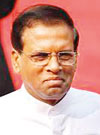
SIRISENA: Tells all
“The following morning, I received a call from Temple Trees saying the President wanted me to come there immediately, “Sirisena said. “ I did not know for what. I quickly got dressed and went to answer the summons. When I went there, Mahinda Rajapaksa was seated as usual in the sitting area and I approached him with a smile on my face. But I have never seen his face so different that day. I hardly could recognise him. It was totally different. I couldn’t imagine whether this was Mahinda Rajapaksa. The moment he saw me, he asked me: ‘Yesterday there had been talk about bribery and corruption in the government. You are the Secretary of the SLFP, a cabinet minister. You can’t remain within the government and talk about bribery and corruption. Why, are you trying to go on another road? ‘
Then Sirisena continues: ‘Then suddenly from the wings, there emerged P. B. Jayasundara, the secretary of Finance. Rajapaksa turned to him and said, ‘PB, you were also there yesterday no, when he talked about bribery and corruption.’ PB turned to me and gave a small smile and then told Mahinda, ‘I have no recollection of it.’
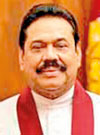
RAJAPAKSA: Why 18A
Realising that coming colours no good, President Sirisena said that he beat a hasty retreat. But on the way out he realised that signalled the parting of their ways. He said: ‘That’s the day I realised that if the party leader’s reaction was such, if that’s the answer I get, when I, the party secretary, a cabinet minister, talk against bribery and corruption, then I should follow a different path. That was the turning point.”
Then Sirisena revealed in his TV interview why President Rajapaksa enacted the 18th Amendment to the Constitution. He said: “When the 18th Amendment was to be enacted there was a discussion about it with President Rajapaksa. This is the truth I am saying. There were about six or seven senior ministers present. When we were discussing the pros and cons of the proposed 18th Amendment, Mahinda Rajapaksa said with a smile on his face,
“‘Yes I know that the 18th Amendment confers a lot of power and that there is a lot of criticism about it. But why did I bring it? Now see, when a person first enters Parliament as a member, if he is in the opposition he thinks when he can be a member of the government. When he becomes a member of the government he thinks ‘I am just wasting my time here’ and wonders when he can be at least a deputy minister of the government where he can do something. When he becomes a deputy minister he thinks ‘I am just wasting my time here’ and wonders when he can be a minister where he can do something. When he becomes a minister of the government he thinks, ‘I cannot do what I want to do ‘and aspires to become the prime minister. When he becomes prime minister he decides the only way he can do something is to become president.’
“At this point,” Sirisena revealed, “one minister asked, ‘So sir, you became president, no? Then Rajapaksa turned towards him and said, ‘Ithin hallo, can’t you understand that even as MP, deputy minister, cabinet minister, prime minister is not satisfied, I too as president is not satisfied being president but want these extra powers? That is why I am bringing this 18th Amendment.’”
Apparently it seems there’s no limit, no boundaries drawn in the quest for power. Whether one armed with the dictatorial powers the 18th Amendment bestowed upon Mahinda Rajapaksa who still sought a third term and countless more or whether Maithripala Sirisena who displays all the signs of going for seconds after having promised the nation on his election he will strictly stick to one serving only diet and no more, the fact remains that power not only corrupts but leaves the holder panting for more.


Leave a Reply
Post Comment